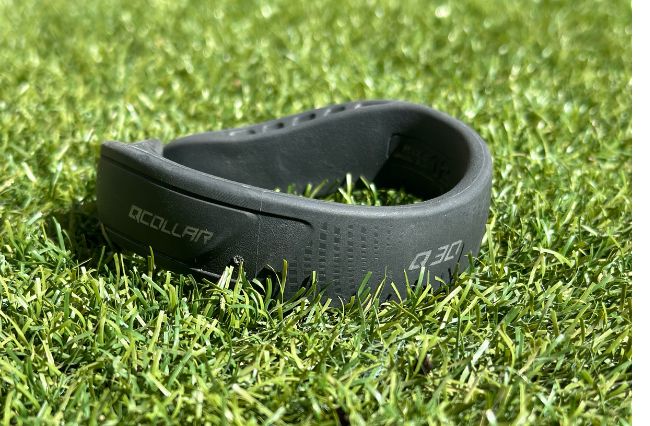The brain is a gelatinous organ that sits in fluid inside the skull. Every time you move, your brain moves as well. Helmets are often used to protect us from head injuries, but they don’t necessarily protect the brain. This is why experts have been looking for solutions.
That solution has now become a reality, and you may have already seen it when watching an NFL game, asking yourself: What is that player wearing around his neck? Back in 2016, Luke Kuechly, Carolina Panthers’ linebacker, was the first NFL player to wear the Q-collar.
The Q-Collar, which its inventors describe it as “a seatbelt for your brain”, is a piece of equipment people can wear around their neck. It was solely created to reduce the incidence of traumatic brain injury for athletes and the military.
The uptake of the device has skyrocketed in the last few years, with athletes from Meghan Klingenberg, Portland Thorns midfielder, to Jack Rowlett, Chaos defender, wearing the collar. So far, it has been used in sports such as soccer, NFL, lacrosse, hockey, bobsleigh and basketball. But since it’s become globally recognised, there are many questions about it. What does it do? Does it actually work?
Vice President of Q30 Innovating, Suzanne Williams, the company that designed the collar, said the Q-Collar is based on nature, and that they came to it by “thinking about the problem from the inside out, versus the outside in”.
One of their inventors, Dr David Smith, was at a military medical convention in Aberdeen discussing how to protect soldiers from concussions and traumatic brain injury due to blast force impacts. During their talk someone asked: Why can woodpeckers bang their heads consistently and are fine? What are they doing that we aren’t?
It turns out, Williams tells upstart, that when woodpeckers are about to bang their heads, they can naturally, very slightly, compress their jugular veins.
“That slows the blood that’s recirculating back to their heart, and it leaves a little bit of extra blood left in their skull,” she said.
“That extra blood fills in the gaps around their brain and it creates a tighter fit. So when they do have an impact, their brain doesn’t have the room to slosh or to move back and forth, which is where the brain injuries occur. That movement is what causes the neurons to shear or to tear.”
Dr Smith took this idea to Dr Julian Bailes, the neurosurgeon who helped discover the first case of chronic traumatic encephalopathy (CTE). They innovated jugular vein compression devices and tested on rats and pigs brains after impacts. Their studies found the animals had an 80 percent reduction in brain injury. The first prototype was made, landing on the slim, cuff design.
One concern the researchers had was whether the compression of the jugular vein might adversely affect the body. However, Williams explained the performance studies guaranteed that a 30 percent compression of the jugular vein would not.
“It’s about 1.2 pounds [0.54kg] of pressure, and that’s the same amount of pressure when wearing a necktie,” she said.
These results were particularly important as the device was also created for people in the military. Therefore, it was crucial to create a design that would not severely affect performance.
“It doesn’t change your reaction time, doesn’t change your heart rate, or your blood oxygen levels.”
Once the device was designed, clinical trials commenced. Partnered with Cincinnati Children’s Hospital, the researchers gathered 400 high school athletes, giving all of them accelerometers, a device that measures the vibrations or motions of a moving body. Only half the group was given a Q-Collar. The athletes played their entire season and underwent MRI scans on their brains before and after the trial.
The study found that 77 percent of athletes who wore the collar saw zero changes in their white brain matter, which are nerve fibres in the brain that allows exchanging of information and communication between different areas of the brain. Conversely, 73 percent of athletes didn’t see significant changes in their white matter.
However, as Williams points out, this study was not based on concussions. It was based on repetitive subconcussive head impacts, which are bumps to the head that do not cause serious symptoms.
“There were twenty athletes in this study in particular that were diagnosed with concussions during their season. Some with the collar, some were not,” she said.
“What they found amongst those 20 athletes were the athletes that wore the collar, their concussions were less severe and they returned to play sooner than the athletes that were not wearing the collar.”
Williams says that white brain matter helps control your emotion, and long-term brain injury can lead to dementia, memory loss or Parkinson’s.
“But other symptoms that you can experience when you have white brain matter damage in the frontal lobes are depression, anxiety, emotional instability, mood swings, and short temperament,” she said.
“When you wear a seat belt in the car and you have an accident, the seat belt is going to help a lot in order to keep you from having a major catastrophe injury… it’s the same thing.”
Rebecca Lane is one of the few Australian athletes to use the collar, during the 2022 Women’s Lacrosse World Championship in Baltimore, Maryland.
During the tournament, Lane had a major collision with an opponent that she suspected caused her headaches, nausea, and inability to focus. She wasn’t able to perform to her normal standard, and couldn’t complete the rest of the game. So, for the next match she decided to wear the Q-Collar.
“I felt an immediate improvement, leading me to wear it for the remainder of the tournament,” Lane told upstart.
Lane said wearing the Q-collar did not affect her performance in a negative way, but it did take some time to get used to.
“After getting through the first drill with it on, I could hardly feel it or notice that I had it on, which allowed me to focus solely on lacrosse.”
After 10 years of research, 25 independently peer reviewed studies, and over 500,000 athletes wearing the collar, the Q-Collar got U.S. Food and Drug Administration (FDA) approval in 2021. This is the first and only FDA-cleared sports equipment. According to the FDA, it may reduce the occurrence of specific changes in the brain that are associated with brain injury.
Jamison Float, Vice President of Q30 Innovating, told The American Society of Mechanical Engineers that they will begin testing new material with their pro athletes to gain their feedback, and aim to roll it out to all consumers in 2024.
Article: Samantha Smith is a third-year Bachelor of Media and Communications (sports journalism) student at La Trobe University. You can follow her at @ssamanthasmith5.
Photo: By author









